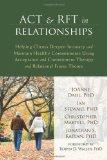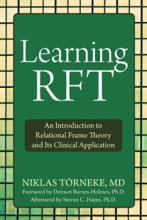ACT and RFT in Relationships: Helping Clients Deepen Intimacy and Maintain Healthy Commitments Using Acceptance and Commitment Therapy and Relational Frame Theory

Dahl, J., Stewart, I., Martell, C., & Kaplan, J.S. (2014). ACT and RFT in Relationships: Helping Clients Deepen Intimacy and Maintain Healthy Commitments Using Acceptance and Commitment Therapy and Relational Frame Theory. Oakland, CA: New Harbinger Publications.
Even if you are not a couples therapist, chances are you have dealt with clients whose problems are based in relationship issues. In order to successfully treat these clients, you must first help them understand what their values are in these relationships, and how their behavior may be undermining their attempts to seek intimacy and connection.
Combining elements of acceptance and commitment therapy (ACT) and relational frame theory (RFT), ACT and RFT for Relationships presents a unique approach for therapists to help clients develop and experience deeper, more loving relationships. By exploring personal values and expectations, and by addressing central patterns of behaviors, therapists can help their clients establish and maintain intimacy with their partner and gain a greater understanding of their relationship as a whole.
ACT is a powerful treatment model that teaches clients to accept their thoughts, identify their core values, and discover how these values are extended to their relationships with others. RFT focuses on behavioral approaches to language and cognition, and can help clients identify their own expectations regarding relationships and how they might communicate these expectations with their loved ones more effectively.
This book aims to shed light on the thought processes behind intimate relationships—from the attraction phase to the end of intimacy—from a functional, contextual perspective.
A Relational Frame Theory Account of the Emergence of Sexual Fantasy
Stockwell, F.M.J. & Moran, D.J. (2013). A Relational Frame Theory Account of the Emergence of Sexual Fantasy. Journal of Sex & Marital Therapy, 00(00), 1-13.
Sexual fantasy is common among humans and often serves to facilitate sexual arousal. Although some fantasies may be directly related to a person’s past experiences, others may be unrelated to direct history, and these are thus more difficult to explain. Relational frame theory is a comprehensive account of human language and cognition that may assist in understanding the processes involved in the emergence of sexual fantasy. This article presents a primer on relational frame theory, along with examples of how relations between stimuli may influence a person’s private experience of sexual fantasy.
Advances in Relational Frame Theory: Research and Application -- Book Interview
Edited by leading Relational Frame Theory (RFT) scholars, Simon Dymond, PhD, and Bryan Roche, PhD, Advances in Relational Frame Theory presents advances in all aspects of RFT research over the last decade, and provides a greater understanding of the core principals of acceptance and commitment therapy (ACT). The book also contains chapters written by Steven C. Hayes and Kelly Wilson, both research-active experts from the RFT community around the world.
2006 - Un estudio del dolor en el marco de la conducta verbal: de las aportaciones de W. E. Fordyce a la Teoría del Marco Relacional (RFT) - Gutiérrez, O., & Luciano, M. C.
APA Citation:
Gutiérrez, O., & Luciano, M. C. (2006). Un estudio del dolor en el marco de la conducta verbal: de las aportaciones de W. E. Fordyce a la Teoría del Marco Relacional (RFT). [An study in the context of verbal behavior: from W.E. Fordyce to Relational Frame Theory (RFT)]. International Journal of Clinical and Health Psychology, 6, 169-188.
Free Videos: Learning About and Applying RFT
Here are some free videos that can help you learn about RFT. These videos were not created for or by ACBS. We merely gathered the videos from various sources for your convenience. (There are additional RFT-relevant videos available to ACBS members).
We hope that you find these free videos useful. Simply click on the links below to browse.
Expansion of OBM: How RFT and ACT Can Influence Our Field
VanStelle, S. E., Koerber, J. L., & Fox, E. J. (2010). Expansion of OBM: How RFT and ACT can influence our field. OBM Network News, 24(3), 11-14.
The present paper was prompted by a discussion that took place on the OBM Network Google group in January/February 2010. The introduction of this paper is designed to provide some context for those OBM Network members who do not follow the Google group postings and, additionally, to provide a brief overview of Relational Frame Theory (RFT) and Acceptance and Commitment Therapy (ACT) to the OBM community.
La Théorie des Cadres Relationnels: La place du Langage dans la Thérapie d'Acceptation et d'Engagement (Relational Frame Theory: The place of language in Acceptance and Commitment Therapy).
Villatte, M. & Monestès, J.L. (2010). La Théorie des Cadres Relationnels: La place du Langage dans la Thérapie d'Acceptation et d'Engagement. Revue Québécoise de Psychologie, 31(3), 85-104.
Résumé
Cet article présente les principes de la Théorie des Cadres Relationnels (TCR), support théorique et expérimental de la Thérapie d’Acceptation et d’Engagement (ACT). Il est notamment montré comment le langage conduit à tenter d’éviter de façon persistante les événements psychologiques douloureux, en dépit d’un résultat inefficace et contreproductif, et comment l’ACT contourne ce piège en diminuant certaines formes de contrôle verbal. Mais l’ACT s’appuie également directement sur le langage car il constitue aussi un outil adaptatif puissant pour entrer en contact avec des conséquences distantes; il devient alors un véritable moteur de la thérapie.
Abstract
The current paper presents the principles of Relational Frame Theory (RFT), theoretical and experimental background of Acceptance and Commitment Therapy (ACT). Notably, it is showed how language leads to persistent attempts of avoiding painful psychological events, in spite of inefficient and counterproductive outcomes, and how ACT bypasses this trap by diminishing certain forms of verbal control. However, ACT also employs language directly because it constitutes a powerful adaptive tool to contact distant consequences; it becomes then a genuine motor of therapy.
Learning RFT

Törneke, N. (2010). Learning RFT: An introduction to relational frame theory and its clinical applications. Oakland, CA: New Harbinger Publications, Inc.
Relational frame theory, or RFT, is the little-understood behavioral theory behind a recent development in modern psychology: the shift from the cognitive paradigm underpinning cognitive behavioral therapy to a new understanding of language and cognition.
Learning RFT presents a basic yet comprehensive introduction to this fascinating theory, which forms the basis of acceptance and commitment therapy. The book also offers practical guidance for directly applying it in clinical work. In the book, author Niklas Törneke presents the building blocks of RFT: language as a particular kind of relating, derived stimulus relations, and transformation of stimulus functions. He then shows how these concepts are essential to understanding acceptance and commitment therapy and other therapeutic models.
Learning RFT shows how to use experiential exercises and metaphors in psychological treatment and explains how they can help your clients. This book belongs on the bookshelves of psychologists, psychotherapists, students, and others seeking to deepen their understanding of psychological treatment from a behavioral perspective.
Relational Frame Theory and Industrial/Organizational Psychology
Stewart, I., Barnes-Holmes, D., Barnes-Holmes, Y., Bond, F., &; Hayes, S.C. (2006). Relational Frame Theory and Industrial/Organizational Psychology. In S.C. Hayes, F.W. Bond, D. Barnes-Holmes, & J. Austin (Eds.), Acceptance and mindfulness at work: Applying acceptance commitment therapy and relational frame theory to organizational behavior management. New York: Plenum Press.
The current paper argues that a Relational Frame Theory account of complex human behavior including an analysis of relational frames, relational networks, rules and the concept of self can provide a potentially powerful new perspective on phenomena in the applied science of industrial/organizational (I/O) psychology. In this article, we first provide a brief description of I/O psychology itself. We then expand on the core features of RFT described earlier in this special issue, including how it addresses rule-governance. Finally we illustrate, using relevant examples, the ways in which these concepts can be used to understand behavior in the I/O arena.
Relational Frame Theory
Stewart,
